Ferro Carril Oeste
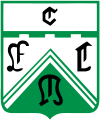 | ||||
| Full name | Club Ferro Carril Oeste | |||
|---|---|---|---|---|
| Nickname(s) | Ferro, Verdolaga, Oeste | |||
| Founded | 28 July 1904 | |||
| Ground |
Ricardo Etcheverri, Caballito, Buenos Aires | |||
| Capacity | 24,442 | |||
| Chairman | Daniel Pandolfi | |||
| Coach | Walter Perazzo | |||
| League | Primera B Nacional | |||
| 2015 | 3° | |||
| Website | Club home page | |||
|
| ||||
Club Ferro Carril Oeste, known simply as Ferro Carril Oeste or Ferro, is an Argentine sports club from the neighbourhood of Caballito, Buenos Aires. Although many activities are hosted by the club, Ferro is mostly known for its football team, currently playing in the Primera B Nacional, the second division of the Argentine football league system.
Apart from football, Ferro Carril Oeste hosts a wide variety of sports that can be practised at the club, such as athletics, basketball, baseball, futsal, handball, field hockey, swimming, taekwondo, tennis, table tennis and volleyball.[1]
History
The beginning
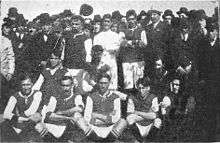
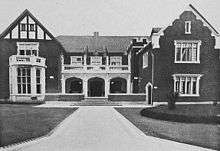
Always located in Caballito, the club was founded as Club Atlético del Ferrocarril Oeste de Buenos Aires on 28 July 1904, by a hundred employees of the Buenos Aires Western Railway (then Ferrocarril Domingo Faustino Sarmiento). The club was approved and supported by railway managers, so Ferro soon incorporated lands to build its headquarters and sports installations. In 1907, Ferro joined the amateur second division, and in 1912 the team won the promotion to the first division after beating Racing Club in the final game.
The Five Musketeers
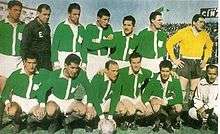
At the end of the 1930s, the club emancipated from the railway company, changing its name to Club Ferro Carril Oeste. In 1937 five talented players rose from the youth divisions, forming an offensive line which would be remembered as The Five Musketeers. They were Bernardo Gandulla, Juan José Maril, Luis Borgnia, Jaime Sarlanga and Raúl Emeal. But those skilled players only played together between 1937 and 1938, due to other clubs acquiring them (Sarlanga would have a memorable run with Boca Juniors). Both Gandulla and Sarlanga together scored more than the 50% of the goals scored by Ferro in the 1937 season
Other notable player for the club was Delfín Benítez Cáceres, who played from 1941 until his retirement in 1944 scoring 20 goals. Gandulla and Emeal returned to Ferro in 1944 after their stint with Boca Juniors. But despite having such prominent players, Ferro finished last in 1946 season and was relegated to Second Division for the first time in its history.
1950s to 1970s
Ferro soon returned to the first division in 1949, when winning the Primera B title. During the 1950 Ferro finished 6th in 1954 and reached a memorable 4th position in 1959, the best team campaign until then. After being relegated again, Ferro won the Primera B championship in 1963, returning to Primera División. In the top level, Ferro reached another 4th place in the 1965 tournament. Ferro would be relegated again, returning in 1970 to the first division.
In 1974 Ferro wore an orange jersey, paying tribute to World sub-champion Netherlands national football team, The Clockwork Orange, finishing 6th in the Torneo Nacional disputed that year. Team's most notable player was central midfielder Gerónimo "Cacho" Saccardi, who had debuted in 1969 and became a legendary player for the institution.
The Golden Age: 1980s
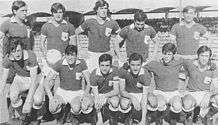
Ferro had a prominent role in Argentine sports in the 1980s, more specifically in football and basketball. The football team won 2 titles of Argentine Primera División and played the Copa Libertadores. Otherwise, the basketball team won the Liga Nacional de Básquet (the Argentine first division league) championship 3 times.
In 1979 Carlos Griguol arrived to the club. He later became the most successful coach in the club's history, winning 2 Primera División titles for the first time and also promoting to Primera players such as Alberto Márcico, Héctor Cúper and Oscar Garré. In 1981 Ferro finished 2nd, totalling 49 points, just one less than champion Boca Juniors. That same year Ferro reached the Torneo Nacional final although the team was defeated by River Plate (by the same score: 1–0 in the two matches played).
Ferro finally won its first title at Primera in 1982, obtaining the Torneo Nacional defeating Quilmes in the finals. The squad played 22 matches, won 16 and tied 6. Ferro scored 50 goals and conceded 13. Left wing Miguel Angel Juárez was the top scorer with 22. Other notable players for the champion team were Adolfino Cañete, Alberto Márcico, Juan Domingo Rocchia and Héctor Cúper.
Although some important players during the 1982 tournament had left (Saccardi, Rocchia, Crocco), Ferro won another Torneo Nacional in 1984, defeating River Plate (with Norberto Alonso and Enzo Francescoli) in the finals (3–0 and 1–0). The team played 14 matches, winning 8 and losing only 1, with 5 draws. Ferro scored 32 goals and only conceded 9, being Márcico the top scorer with 5 goals.
Another important achievement for Ferro was the 2nd place in the 1984 Torneo Metropolitano, finishing with 50 points, only one less than champion Argentinos Juniors. Ferro also played the 1985 Copa Libertadores, being eliminated in the first round by Argentinos Juniors.
But Ferro not only won 2 titles in first division, but also set three notable records in the Argentine Primera:
- In the 1981 Metropolitano championship, goalkeeper Carlos Barisio set a national record by keeping a clean sheet for 1,075 minutes of football. This included a run of 10 complete games without letting in a goal.
- When Ferro won the 1982 Nacional, Ferro also achieved it without losing a single game. In addition, the club was the second team to achieve the feat after San Lorenzo. River Plate and Boca Juniors also achieved this feat later in the 1990s.
On the other hand, Ferro has the longest run without scoring a goal. The team went 875 minutes without scoring between the end of the 1998 Apertura and the 1999 Clausura.
In 1987 Carlos Griguol left the club, and was hired by River Plate. He had won 2 titles in the first division (who still are the only two championships won by Ferro at the top level of Argentine football) and 2 sub-championships. Griguol returned in 1988, coaching Ferro until 1993.
In 1990's Ferro's form gradually declined and relegated to third level in 2001 after two consecutive relegations. Ferro finally returned to second one in 2003.
Ferro has a strong rivalry with Vélez Sársfield, so both teams disputed what is known as Clásico del Oeste.
Kit uniform evolution
1904–07 |
1907–11 |
1911–present |
- Rare editions
1952 [2] |
1966 [2] |
1974 [2] |
Players
Current squad
Current squad of Ferro Carril Oeste as of July 08, 2015
()
Sources: BDFA
|
|
Manager: Luis Medero
Former players
 Vicente Gambardella (1960)
Vicente Gambardella (1960)
Managers
 Mario Fortunato (1937), (1953)
Mario Fortunato (1937), (1953) Pedro Dellacha (1965)
Pedro Dellacha (1965) Victorio Spinetto (1973–76)
Victorio Spinetto (1973–76) Carlos Griguol (1979–87), (1988–93)
Carlos Griguol (1979–87), (1988–93) Gerónimo Saccardi (1997–99)
Gerónimo Saccardi (1997–99) Rubén Darío Insúa (1999)
Rubén Darío Insúa (1999) Héctor Rivoira (2004–05)
Héctor Rivoira (2004–05) José Luis Brown (2007–08)
José Luis Brown (2007–08) Carlos Trullet (2008–09)
Carlos Trullet (2008–09) Jorge Luis Ghiso (2009)
Jorge Luis Ghiso (2009) Dalcio Giovagnoli (2010)
Dalcio Giovagnoli (2010) Mario Gómez (2011–12)
Mario Gómez (2011–12) José Luis Brown (2013)
José Luis Brown (2013) José Romero (2014)
José Romero (2014) Marcelo Broggi (2015)
Marcelo Broggi (2015) Walter Perazzo (2016–)
Walter Perazzo (2016–)
Other sports
Basketball
Honours
Football
- Primera División (2): 1982 Nacional, 1984 Nacional
- Primera B (6): 1958, 1963, 1969, 1970, 1978, 2002–03
- División Intermedia (1): 1912
- Copa Bullrich (2): 1912, 1913
Volleyball
- Men
- Primera División (6): 1977, 1980, 1981, 1983, 1984, 1985
- Copa Morgan (7): 1966, 1977, 1977, 1983, 1984, 1985, 1986
- Campeonato Sudamericano (2): 1987, 1998
- Women
- Primera División (8): 1979, 1980, 1981, 1982, 1983, 1984, 1985, 1990
- Copa Morgan (11): 1977, 1978, 1980, 1981, 1983, 1984, 1986, 1987, 1988, 1998, 2004
References
- ↑ "Deportes federados", club website, retrieved 21 December 2012
- 1 2 3 El Nacimiento de una Pasión, Alejandro Fabbri, Capital Intelectual ediciones (2006)
External links
| Wikimedia Commons has media related to Ferro Carril Oeste. |
- Official website (Spanish)
- Ferro C. Oeste (not official) (Spanish)
- Pasión Verdolaga
- Ferroweb (Spanish)
- Energía Verde (Spanish)